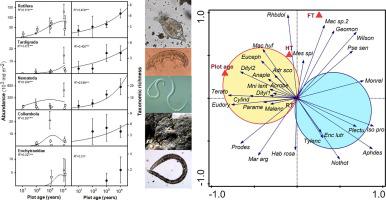Our official English website, www.x-mol.net, welcomes your feedback! (Note: you will need to create a separate account there.)
Terrestrial invertebrates along a gradient of deglaciation in Svalbard: Long-term development of soil fauna communities
Geoderma ( IF 6.1 ) Pub Date : 2021-02-01 , DOI: 10.1016/j.geoderma.2020.114720 Miloslav Devetter , Ladislav Háněl , Natália Raschmanová , Michala Bryndová , Jiří Schlaghamerský
Geoderma ( IF 6.1 ) Pub Date : 2021-02-01 , DOI: 10.1016/j.geoderma.2020.114720 Miloslav Devetter , Ladislav Háněl , Natália Raschmanová , Michala Bryndová , Jiří Schlaghamerský

|
Abstract The recent deglaciation of large polar areas has exposed stretches of land, allowing spontaneous primary succession. The exposed substrate is colonized by soil biota participating in soil formation – a process in which soil characteristics and the biotic community affect each other mutually. Soil fauna was studied along three transects in glacier valleys around Petunia Bay on Svalbard in the High Arctic, representing chronosequences of soil development on plots deglaciated for ten to approximately ten thousand years. Community development was characterised by progressive addition of species, with many pioneer species remaining present throughout soil development. Generally, the abundance and species richness of soil animals increased from the initial to the well-developed sites. Altogether 93 taxa of soil fauna were identified, including 21 species of rotifers, 38 genera of nematodes, 8 species of tardigrades, 21 species of springtails and 4 species of enchytraeids. Rotifers were the earliest colonizers, found already in the initial stage, followed by nematodes in plots several tens of years old. They were followed by tardigrades, which – although in low abundances – established populations in the third stage of the chronosequences, 103-year-old. Collembolans formed stable populations at the end of the chronosequence in the third and fourth stages, 103 to 104 years old. Enchytraeids only appeared at the end of the chronosequence. Assemblages were significantly driven mostly by the age of the plot, association with a given transect and nutrient availability.
中文翻译:

斯瓦尔巴特群岛沿冰川消退梯度的陆生无脊椎动物:土壤动物群落的长期发展
摘要 大片极地地区最近的冰川消融暴露了大片土地,允许自发的初级演替。暴露的基质被参与土壤形成的土壤生物群所定植——土壤特征和生物群落相互影响的过程。沿着北极高地斯瓦尔巴群岛矮牵牛湾周围冰川山谷的三个横断面研究了土壤动物群,代表了十年到大约一万年冰川消融的地块上土壤发育的时间序列。群落发展的特点是逐渐增加物种,在整个土壤发育过程中仍然存在许多先锋物种。总体上,土壤动物的丰度和物种丰富度从初始地到发达地都有所增加。共确定了 93 个土壤动物分类群,其中轮虫21种,线虫38属,缓步动物8种,跳虫21种,线虫4种。轮虫是最早的殖民者,已经在初始阶段发现,其次是线虫在几十年前的地块中。紧随其后的是缓步动物,尽管它们的丰度很低,但它们在时间序列的第三阶段建立了种群,已有 103 年的历史。跳虫在第三和第四阶段的时间序列结束时形成稳定的种群,年龄为 103 至 104 岁。Enchytraeids 只出现在时间序列的末尾。组合主要受地块年龄、与给定横断面和养分可用性的关联显着驱动。21种跳虫和4种跳虫。轮虫是最早的殖民者,已经在初始阶段发现,其次是线虫在几十年前的地块中。紧随其后的是缓步动物,尽管它们的丰度很低,但它们在时间序列的第三阶段建立了种群,已有 103 年的历史。跳虫在第三和第四阶段的时间序列结束时形成稳定的种群,年龄为 103 至 104 岁。Enchytraeids 只出现在时间序列的末尾。组合主要受地块年龄、与给定横断面和养分可用性的关联显着驱动。21种跳虫和4种跳虫。轮虫是最早的殖民者,已经在初始阶段发现,其次是线虫在几十年前的地块中。紧随其后的是缓步动物,尽管它们的丰度很低,但它们在时间序列的第三阶段建立了种群,已有 103 年的历史。跳虫在第三和第四阶段的时间序列结束时形成稳定的种群,年龄为 103 至 104 岁。Enchytraeids 只出现在时间序列的末尾。组合主要受地块年龄、与给定横断面和养分可用性的关联显着驱动。尽管丰度低,但在时间序列的第三阶段建立了种群,已有 103 年的历史。跳虫在第三和第四阶段的时间序列结束时形成稳定的种群,年龄为 103 至 104 岁。Enchytraeids 只出现在时间序列的末尾。组合主要受地块年龄、与给定横断面和养分可用性的关联显着驱动。尽管丰度低,但在时间序列的第三阶段建立了种群,已有 103 年的历史。跳虫在第三和第四阶段的时间序列结束时形成稳定的种群,年龄为 103 至 104 岁。Enchytraeids 只出现在时间序列的末尾。组合主要受地块年龄、与给定横断面和养分可用性的关联显着驱动。
更新日期:2021-02-01
中文翻译:

斯瓦尔巴特群岛沿冰川消退梯度的陆生无脊椎动物:土壤动物群落的长期发展
摘要 大片极地地区最近的冰川消融暴露了大片土地,允许自发的初级演替。暴露的基质被参与土壤形成的土壤生物群所定植——土壤特征和生物群落相互影响的过程。沿着北极高地斯瓦尔巴群岛矮牵牛湾周围冰川山谷的三个横断面研究了土壤动物群,代表了十年到大约一万年冰川消融的地块上土壤发育的时间序列。群落发展的特点是逐渐增加物种,在整个土壤发育过程中仍然存在许多先锋物种。总体上,土壤动物的丰度和物种丰富度从初始地到发达地都有所增加。共确定了 93 个土壤动物分类群,其中轮虫21种,线虫38属,缓步动物8种,跳虫21种,线虫4种。轮虫是最早的殖民者,已经在初始阶段发现,其次是线虫在几十年前的地块中。紧随其后的是缓步动物,尽管它们的丰度很低,但它们在时间序列的第三阶段建立了种群,已有 103 年的历史。跳虫在第三和第四阶段的时间序列结束时形成稳定的种群,年龄为 103 至 104 岁。Enchytraeids 只出现在时间序列的末尾。组合主要受地块年龄、与给定横断面和养分可用性的关联显着驱动。21种跳虫和4种跳虫。轮虫是最早的殖民者,已经在初始阶段发现,其次是线虫在几十年前的地块中。紧随其后的是缓步动物,尽管它们的丰度很低,但它们在时间序列的第三阶段建立了种群,已有 103 年的历史。跳虫在第三和第四阶段的时间序列结束时形成稳定的种群,年龄为 103 至 104 岁。Enchytraeids 只出现在时间序列的末尾。组合主要受地块年龄、与给定横断面和养分可用性的关联显着驱动。21种跳虫和4种跳虫。轮虫是最早的殖民者,已经在初始阶段发现,其次是线虫在几十年前的地块中。紧随其后的是缓步动物,尽管它们的丰度很低,但它们在时间序列的第三阶段建立了种群,已有 103 年的历史。跳虫在第三和第四阶段的时间序列结束时形成稳定的种群,年龄为 103 至 104 岁。Enchytraeids 只出现在时间序列的末尾。组合主要受地块年龄、与给定横断面和养分可用性的关联显着驱动。尽管丰度低,但在时间序列的第三阶段建立了种群,已有 103 年的历史。跳虫在第三和第四阶段的时间序列结束时形成稳定的种群,年龄为 103 至 104 岁。Enchytraeids 只出现在时间序列的末尾。组合主要受地块年龄、与给定横断面和养分可用性的关联显着驱动。尽管丰度低,但在时间序列的第三阶段建立了种群,已有 103 年的历史。跳虫在第三和第四阶段的时间序列结束时形成稳定的种群,年龄为 103 至 104 岁。Enchytraeids 只出现在时间序列的末尾。组合主要受地块年龄、与给定横断面和养分可用性的关联显着驱动。


























 京公网安备 11010802027423号
京公网安备 11010802027423号